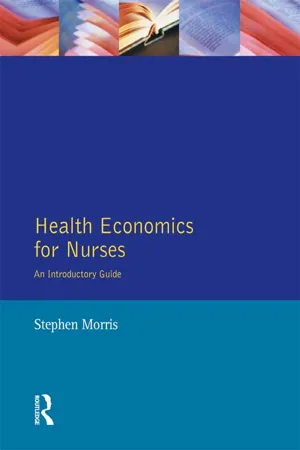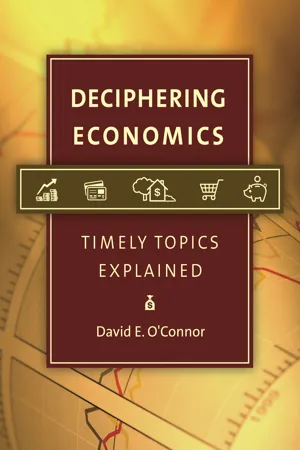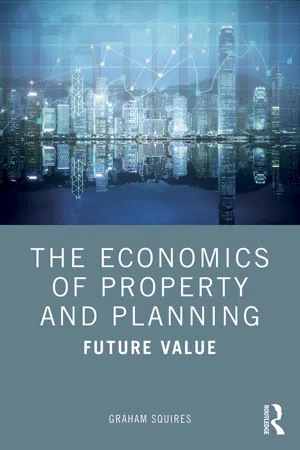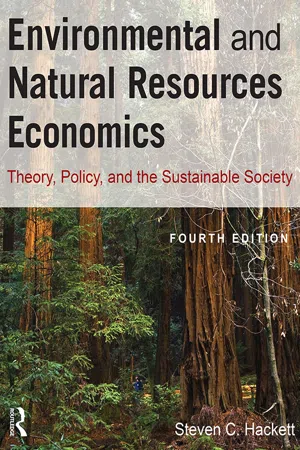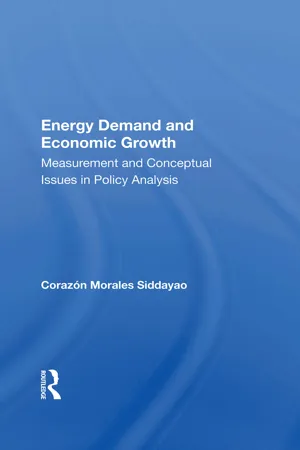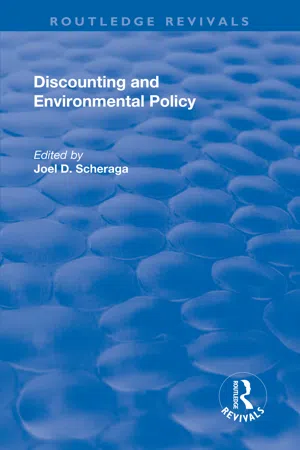Economics
The Demand for Resources
The demand for resources refers to the quantity of inputs, such as labor, capital, and natural resources, that firms and individuals are willing and able to purchase at various prices. It is influenced by factors such as the price of the resource, the prices of related goods, and technological advancements. Understanding resource demand is crucial for analyzing production and pricing decisions in an economy.
Written by Perlego with AI-assistance
Related key terms
8 Key excerpts on "The Demand for Resources"
- eBook - ePub
Health Economics For Nurses
Intro Guide
- Stephen Morris(Author)
- 2014(Publication Date)
- Routledge(Publisher)
2 Basic theory of economics: demand, supply and the market solutionIn this chapter we examine the basic aspects of economic theory which lay the foundation for the analysis of the following chapters. The discussion concentrates on the development and explanation of the basic tools of economics: demand, supply and markets, and how they may be used in response to the problem of scarcity. The discussion is general in nature, and is not specifically related to health care or nursing at this stage. These issues will be examined in following chapters.Summary1. The basic problem which economics attempts to address is that of scarce resources. Because of scarcity, all economic decisions necessarily involve a choice in terms of what goods to produce, how to produce them and who shall receive them.2. One way of addressing these issues is to use the notion of a market, in which resource allocation decisions are determined by the independent decisions of consumers and producers, and signals in the form of prices are used to allocate resources.3. There are two components of a market: demand and supply.4. The quantity of a good that consumers are willing and able to buy in a specific time period is called the demand for a good, and is influenced by many variables including the price of the good, income, the prices of other goods and tastes.5. There is, in general, an inverse relationship between the price of a good and the quantity demanded of that good. 6. The demand curve may be derived using the Law of Diminishing Marginal Utility and the assumption that consumers wish to maximise their utility. 7. By supply we mean the quantity of a good that producers will wish to offer for sale at a particular price per time period. 8. The quantity supplied of a good is also influenced by a number of variables, such as the price of the good, the prices of other goods and the costs of production. 9. There is, in general, a positive relationship between the price of a good and the quantity supplied of that good. - eBook - ePub
Deciphering Economics
Timely Topics Explained
- David E. O'Connor(Author)
- 2014(Publication Date)
- Greenwood(Publisher)
inner circle shows the flow of the money payments as these payments travel through the American economy. In the factor market, businesses make money payments to households in the form of wages and salaries, interest, rents, and entrepreneurial profits. These money payments, which are the costs of production for businesses, become sources of income for households. Households, in turn, use their income to buy finished goods and services in the product market. This household spending on goods and services becomes revenues for businesses. Business revenues enable firms to buy resources from households—and so the money flow continues. In the American market economy, the flows in both the product market and the factor market are free from most types of government regulation.Demand
A central feature of a market economy is the efficient operation of free markets. A market occurs whenever two or more parties freely exchange something of value. Recall from the circular flow model that there are two primary types of markets, a product market where households buy products from businesses and a factor market where businesses buy resources from households. There are countless exchanges that take place in the U.S. product market and factor market every day. But how are the prices for goods, services, and resources determined? In a market economy, the impersonal forces of demand and supply establish most prices and, in doing so, bring order to the seeming chaos of the marketplace.Demand
Demand is the amount of a good, service, or resource that people are willing and able to buy at a series of prices at a moment in time. The demand for a product or resource is illustrated in tabular form by a demand schedule, or with a demand curve, as shown in Figure 2.4 . The demand curve slopes downward, reflecting the most famous of all economic laws, the law of demand. According to the law of demand , there is an inverse relationship between price and quantity demanded. That is, if the price of a good increases, the quantity demanded will decrease. Conversely, if the price of a good decreases, the quantity demanded will increase.To construct an initial demand curve for a product, economists employ the ceteris paribus assumption. Under the ceteris paribus assumption, all external factors that might affect the demand for the product, except price, are temporarily held constant. In the product market, the demand curve typically represents the viewpoint of the consumer, who buys final goods or services from businesses. In the factor market, the demand curve typically represents the viewpoint of the producer, who buys resources from households. - eBook - ePub
Technology Entrepreneurship
Creating, Capturing, and Protecting Value
- Thomas N. Duening, Robert A. Hisrich, Michael A. Lechter(Authors)
- 2009(Publication Date)
- Academic Press(Publisher)
The issue of allocation is not limited to scarce resources. It also involves the distribution of goods and services to the consumer. In this context, allocation involves an exchange (e.g., money, goods, time, services) between a business and a consumer (e.g., client, customer, another business). In an ideal pattern of distribution in a market economy, the business earns a profit and the customer is satisfied with the goods or service; the exchange provides mutual benefit. This is important in a market economy. A tailor able to earn a profit is likely to continue to work hard at the job. Likewise, a customer who likes the price and quality of the tailor's services will continue to use that tailor. When goods and services get to the customers who want or need them and mutual satisfaction occurs, both resources and products have been well allocated.2.2. Supply, Demand, and Pricing
When there is little or no government intervention and control in an economy, the underlying law of supply and demand dominates the allocation of goods and services. Supply is the amount of goods and services sellers are willing to offer at various prices in a given time period and market condition. Demand is the amount of goods and services buyers are willing to purchase at various prices in the same time period and market conditions. The interaction of these two forces determines the market price as well as the amount of the product that will be produced and sold. Often buyers and sellers do not agree, and the equilibrium price does not correctly reflect the value of the quantity of the goods and services in the market. When this occurs, there is either a shortage (excess demand versus supply) or a surplus (excess supply versus demand).In a competitive market economy, when a surplus or a shortage occurs, firms enact price changes until equilibrium is restored. In the case of a surplus, prices tend to be driven lower to meet the prevailing demand level in the short run. In the long run, either the supply will decrease, as the quantities offered are decreased by some firms making production cuts or by other firms going out of business, or the actual demand will change (increase) owing to buyers' willingness to purchase more of the product at the reduced prices.When a shortage occurs, a company must carefully assess whether this condition is simply temporary or is actually a true market need not being satisfied. In these cases, prices rise to bring demand in line with current supply. Higher prices that can be charged in a strong customer demand environment may encourage new firms to enter the industry, increasing the available supply and putting downward pressure on prices. Technology entrepreneurs who have a relatively scarce yet high demand offering may be able to charge high prices in the short run. In the long run, competitors would respond to these pricing opportunities with offerings of their own, eventually pushing prices to a new equilibrium. One way to protect pricing advantage is to establish intellectual property that provides a competitive advantage or one could develop some other type of competitive advantage that can be sustained over time. - eBook - ePub
The Economics of Property and Planning
Future Value
- Graham Squires(Author)
- 2021(Publication Date)
- Routledge(Publisher)
With regard to for ‘whom’ these goods and services are realised and by which method, different social groupings may benefit or lose depending on particular social cleavages such as wealth and class (lower, middle, upper, under), race, religion, gender, age, and sexuality. Particular minorities and majorities will benefit from the choices made in society – including private decisions by for instance commercial property interests and public interests such as politicians seeking the best combination of public returns for their constituents. Different goods (e.g. the production of merit goods such as education) and how they are produced (e.g. public, private, or a combination) will affect who ultimately receives the good or service. As an example, not all schoolchildren will be able to afford private education and would not be able to receive education.So more broadly, economics is the study of how society decides what, how, and for whom to produce. It is the decisions made by society that are of importance in determining the three questions of what, how, and for whom to produce – and these decisions can often be influenced by the level of ‘wants’ and ‘resources’ available.Resources, wants, and scarcity
At either end of the spectrum in which wants and resources are situated is the idea of ‘Infinite Wants’ on one end, and ‘Scarce Resources’ on the other. Infinite wants hold the notion that people are hard-wired to always want to consume more goods, services, and experiences. Scarce resources in the form of factors of production (Land, Labour, Capital, and Entrepreneurship) restrict the ability for all of these infinite wants to be satisfied completely – as scarcity defines the resources as having limited availability. Due to this mismatch of infinite wants and scarce resources, it is thought in economic terms that a choice will need to be made.Using a property and planning example, a situation can be described where residents will want to live in a property that allows an improved quality of life – such as whether that is a better location, better school catchment, areas with low crime, commutable to suitable employment, and near to recreation space. However, these wants are curtailed due to the scarcity of resources, for instance, there is only finite (or even unique) land available for desirable locations, there are a limited number of available schools, not all locations are crime (or fear of crime) free, the commute time to work will have a limit, and there is only a finite amount of land available for recreation. As a result, this housing example demonstrates that the wants will not be completely satisfied given the scarce resources (and factors of production), and a compromise and choice will have to be made. This idea of choice can be aggregated to a national scale and demonstrate that not all of a nation’s inhabitants will be satisfied. - eBook - ePub
- Dr Paul Balchin, Paul Balchin, Maureen Rhoden(Authors)
- 2002(Publication Date)
- Routledge(Publisher)
Second, the production or consumption of certain goods may produce negative effects on the economic well-being of consumers or producers elsewhere in society, and these spillover or external effects are known as negative externalities. Governments usually try to limit these effects either by regulation (e.g. to remove lead in paint used for domestic purposes) or by means of some form of taxation (e.g. the recently introduced tax on waste disposal in landfill sites).Third, there is a range of goods and services known as ‘public goods’ where charging to cover full costs of provision would be either impractical or inefficient. For example, charging for entry to the National Parks or for the actual use of street-lighting would either be virtually impossible or prohibitively expensive, and if supply depended on revenue obtained, the market would only rarely, if ever, supply such goods or services.To summarise, while resource allocation is generally left to the market mechanism, most ‘mixed’ economies retain varying proportions of government intervention, to either encourage or discourage some types of production/consumption or, more directly, in the public provision of certain goods or services. The next section looks in more detail at the underlying factors determining supply and demand for particular commodities and at the operation of the market mechanism.DEMAND AND SUPPLY AND THE DETERMINATION OF MARKET EQUILIBRIUM
Within a freely operating market, the price of any good will depend on the interaction of demand and supply. All commodities that are bought and sold, whether on a fruit stall or the stock market, are priced to reflect current conditions of supply and demand. Movements in the market price can occur if these underlying conditions change.The demand curve for a commodity
Demand can be defined as the quantity of a commodity consumers are willing to purchase at a particular price. The demand for most commodities will rise as their price falls and fall as their price rises and there is therefore an inverse relationship between price and quantity demanded. This can be understood more clearly when we realise that the market demand for a commodity is itself made up entirely of the individual demands of consumers or producers. Individual consumers will have a choice of alternative products in any single category (for example, different makes of cars), and they will also be constrained by fixed levels of income. If the market price of a commodity rises, consumers will have to either reduce their consumption of the good or find a suitable alternative or they will have to reduce their consumption of another good. A similar pattern will emerge for commodities which are demanded mainly by producers. For example, if there is a rise in the price of bricks, producers (e.g. construction firms) will try to substitute other materials such as timber, cement or steel (the prices of which we assume have not risen) for bricks in the production process (in this case construction). - eBook - ePub
Environmental and Natural Resources Economics
Theory, Policy, and the Sustainable Society
- Steven Hackett, Sahan T. M. Dissanayake(Authors)
- 2014(Publication Date)
- Routledge(Publisher)
Chapter 5 Natural Resources Economics Part I: Theory and Concepts
DOI: 10.4324/9781315704586-5Introduction and Overview
Environmental economics is primarily concerned with identifying externalities and evaluating regulatory policies designed to control them. Traditionally, natural resources economics has been concerned with the optimal use and management of natural resource systems. An element of nature is a natural resource when it is directly useful to people, or when human technology can utilize it to form something valuable. For example, petroleum bubbling up through the ground and fouling soil was considered a nuisance to farmers in the nineteenth century until the development of refining and internal combustion engine technology transformed this material into a valuable natural resource. More recently, porous underground rock formations near coal-fired power plants have become valuable resources for carbon capture and sequestration, and new systems of property law are being developed to determine ownership and use of this resource.Natural Resources Economics Field of study that focuses on the supply, demand, management, and allocation of Earth’s natural resources.As will be shown in this chapter, the price of a natural resource reflects the relative scarcity of the resource and the availability of substitutes, and it acts as a driver for technological innovation. Increasing scarcity will tend to increase the resource’s price, reduce quantity demanded, and promote the production and consumption of substitutes.The dramatic peak in petroleum prices in the summer of 2008 offers an interesting illustration of how firms and households respond to a volatile energy resource market. Between January 2007 and July 2008, the average price of gasoline in the United States rose by nearly 80 percent. Smith (2009) - eBook - ePub
Energy Demand And Economic Growth
Measurement And Conceptual Issues In Policy Analysis
- Corazon M Siddayao(Author)
- 2021(Publication Date)
- Routledge(Publisher)
2 Understanding the Demand for Energy DOI: 10.4324/9780429038563-3This discussion assumes that the reader has some basic understanding of the notion of demand for a commodity and the related concepts of elasticities. Appendix 2.1 provides a brief refresher for those requiring it.The Demand for Energy
The principal determinants of demand are (1) the possible prices of commodity X; (2) the prices and availability of closely related commodities, both substitutes and complements; (3) the prices of other commodities that compete for the buyer's disposable income; (4) the buyer's disposable income; (5) buyer preferences; (6) buyer expectations; and (7) technology.Energy demand is a derived demand, and thus the price and availability of related goods as demand determinants includes both the prices and availability of competing fuels or energy sources and those of appliances or processes requiring the use of a particular fuel. The preferences of the buyer include the effects on purchasing decisions or choices of promotional activities of gas and electric companies or appliance dealers, climatic conditions, and regional factors such as the dispersion of communities. In industry demand the preferences category would include technology because given the demand for the industry's output, current production technology will dictate the level of consumption of any specific energy resource. Expectations might also comprise profit expectations because energy in this sector is a production input and depends, among other things, on the level of demand for the industry's output and on cost considerations.If demand is viewed from an aggregated level, additional variables include population change and the related demographic characteristics. Income could then be viewed in terms of income per caput. More specific studies might add a more refined definition in terms of the distribution of income because, as pointed out earlier, the marginal propensity to consume at higher levels of income may very well differ from that at relatively lower levels. - eBook - ePub
- Joel Scheraga(Author)
- 2018(Publication Date)
- Routledge(Publisher)
I think the correct conclusion to be drawn from this discussion is not that either of the stories is more likely to be true. It is more complex: that in tranquil conditions, resource markets are likely to track their equilibrium paths moderately well, or at least not likely to rush away from them. But resource markets may be rather vulnerable to surprises. They may respond to shocks about the volume of reserves, or about competition from new materials, or about the costs of competing technologies, or even about near-term political events, by drastic movements of current price and production. It may be quite a while before the transvaluation of values—I never thought I could quote Nietzsche in an economics paper—settles down under the control of sober future prospects. In between, it may be a cold winter.So far, I have discussed the economic theory of exhaustible resources as a partial-equilibrium market theory. The interest rate that more or less controls the whole process was taken as given to the mining industry by the rest of the economy. So was the demand curve for the resource itself. And when the market price of the resource has ridden up the demand curve to the point where the quantity demanded falls to zero, the theory says that the resource in question will have been exhausted.There is clearly a more cosmic aspect to the question than this; and I do not mean to suggest that it is unimportant, just because it is cosmic. In particular, there remains an important question about the social interest in the pace of exploitation of the world’s endowment of exhaustible natural resources. This aspect has been brought to a head recently, as everyone knows, by the various Doomsday forecasts that combine a positive finding that the world is already close to irreversible collapse from shortage of natural resources and other causes with the normative judgment that civilization is much too young to die. I do not intend to discuss those forecasts and judgments now—this convention already has one session devoted to just that—but I do want to talk about the economic issues of principle involved.First, there is a proposition that will be second nature to everyone in this room. What I have called the fundamental principle of the economics of exhaustible resources is, among other things, a condition of competitive equilibrium in the sequence of futures markets for deliveries of the natural resource. This sequence extends out to infinity, even if the competitive equilibrium calls for the resource to be exhausted in finite time. Beyond the time of exhaustion there is also equilibrium: supply equals demand equals zero at a price simultaneously so high that demand is choked off and so low that it is worth no one’s while to lose interest by holding some of the resource that long. Like any other competitive equilibrium with the right background assumptions, this one has some optimality properties. In particular, as Hotelling pointed out, the competitive equilibrium maximizes the sum of the discounted consumer-plus-producer surpluses from the natural resource, provided
Index pages curate the most relevant extracts from our library of academic textbooks. They’ve been created using an in-house natural language model (NLM), each adding context and meaning to key research topics.
